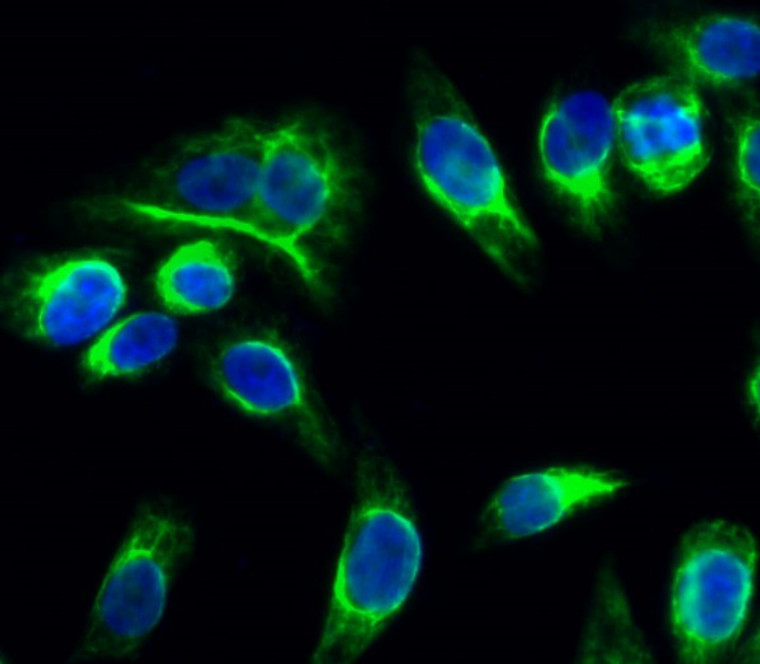| Host: |
Rabbit |
| Applications: |
WB/IHC/IF/ELISA |
| Reactivity: |
Human/Mouse/Rat |
| Note: |
STRICTLY FOR FURTHER SCIENTIFIC RESEARCH USE ONLY (RUO). MUST NOT TO BE USED IN DIAGNOSTIC OR THERAPEUTIC APPLICATIONS. |
| Short Description: |
Rabbit polyclonal antibody anti-Catenin alpha-1 and Catenin alpha-2 (857-906 aa) is suitable for use in Western Blot, Immunohistochemistry, Immunofluorescence and ELISA research applications. |
| Clonality: |
Polyclonal |
| Conjugation: |
Unconjugated |
| Isotype: |
IgG |
| Formulation: |
Liquid in PBS containing 50% Glycerol, 0.5% BSA and 0.02% Sodium Azide. |
| Purification: |
The antibody was affinity-purified from rabbit antiserum by affinity-chromatography using epitope-specific immunogen. |
| Concentration: |
1 mg/mL |
| Dilution Range: |
WB 1:500-1:2000IHC 1:100-1:300IF 1:200-1:1000ELISA 1:5000 |
| Storage Instruction: |
Store at-20°C for up to 1 year from the date of receipt, and avoid repeat freeze-thaw cycles. |
| Gene Symbol: |
CTNNA1CTNNA2 |
| Gene ID: |
14951496 |
| Uniprot ID: |
CTNA1_HUMANCTNA2_HUMAN |
| Immunogen Region: |
857-906 aa |
| Specificity: |
Catenin-Alpha E/N Polyclonal Antibody detects endogenous levels of Catenin-Alpha E/N protein. |
| Immunogen: |
The antiserum was produced against synthesized peptide derived from the human Catenin-alpha1 at the amino acid range 857-906 |
| Post Translational Modifications | Sumoylated. Phosphorylation seems to contribute to the strength of cell-cell adhesion rather than to the basic capacity for cell-cell adhesion. |
| Function | Associates with the cytoplasmic domain of a variety of cadherins. The association of catenins to cadherins produces a complex which is linked to the actin filament network, and which seems to be of primary importance for cadherins cell-adhesion properties. Can associate with both E- and N-cadherins. Originally believed to be a stable component of E-cadherin/catenin adhesion complexes and to mediate the linkage of cadherins to the actin cytoskeleton at adherens junctions. In contrast, cortical actin was found to be much more dynamic than E-cadherin/catenin complexes and CTNNA1 was shown not to bind to F-actin when assembled in the complex suggesting a different linkage between actin and adherens junctions components. The homodimeric form may regulate actin filament assembly and inhibit actin branching by competing with the Arp2/3 complex for binding to actin filaments. Involved in the regulation of WWTR1/TAZ, YAP1 and TGFB1-dependent SMAD2 and SMAD3 nuclear accumulation. May play a crucial role in cell differentiation. |
| Protein Name | Catenin Alpha-1Alpha E-CateninCadherin-Associated ProteinRenal Carcinoma Antigen Ny-Ren-13 |
| Database Links | Reactome: R-HSA-418990Reactome: R-HSA-5218920Reactome: R-HSA-525793Reactome: R-HSA-5626467 |
| Cellular Localisation | Isoform 1: CytoplasmCytoskeletonCell JunctionAdherens JunctionCell MembranePeripheral Membrane ProteinCytoplasmic SideFound At Cell-Cell Boundaries And Probably At Cell-Matrix BoundariesIsoform 3: Cell Membrane |
| Alternative Antibody Names | Anti-Catenin Alpha-1 antibodyAnti-Alpha E-Catenin antibodyAnti-Cadherin-Associated Protein antibodyAnti-Renal Carcinoma Antigen Ny-Ren-13 antibodyAnti-CTNNA1 antibody |
Information sourced from Uniprot.org
12 months for antibodies. 6 months for ELISA Kits. Please see website T&Cs for further guidance









